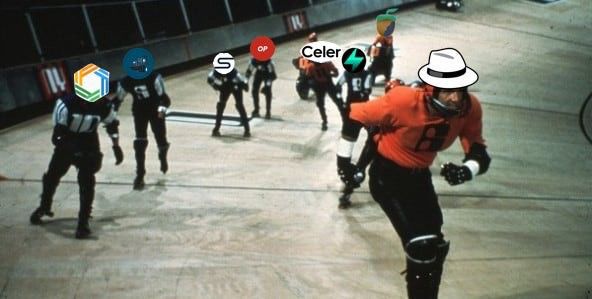Important Ethereum Capacity Expansion Solution: Optimistic Rollup Status Report (Part 1)
If it were not for the fact that this research report was commissioned by MolochDAO, I think DAOSquare would not translate such "technical" academic papers (at least not at this stage). However, the scalability of Ethereum is indeed an important and hot topic. The existing solutions include Optimistic Rollup and Zk Rollup. Optimistic Rollup is an emerging solution that has not been proposed for a long time. It is considered to be the most promising Expansion plan. So how is it developing today? What's the future? Daniel Goldman, the author of this article, completed this report through a lot of research, and now DAOSquare will share this result with everyone! However, because the space is too "big", we will present it in three phases, this is the first part.
Author: Daniel Goldman (Daniel Goldmann) free software engineer, technical consultant, writer
Translators: Emma, Snow Lu
Proofreading: Samuel
- Is the halving market over? "Wolf Coming" staged again
- The currency circle is a casino. Is technical analysis useful?
- Faced with the crisis in developed countries, Bitcoin's risk aversion ability breaks down
Technical overview of Ethereum's emerging Optimistic Rollup ecosystem

Optimistic Rollerball (Daniel Goldman original, 2020)
The following report was authored by MolochDAO with John Adler providing relevant comments / reviews; however, all opinions expressed in this article are my own. In addition, the project evaluation is only a status brief at the time of publication of the report (February 2020). Everything is changing without over-commitment.
Haze over Ethereum's expansion community-Optimsitc Rollup
In the second half of 2019, Optimistic Rollups (ORU or Optiroll) as the Ethereum Layer 2 capacity expansion agreement quickly gained popularity. This article aims to provide an overview of the development ecosystem of the emerging ORU as of press time (February 2020). We first put the ORU theoretical attributes in the context of the Layer 2 design space, and then compared the method and technical design decisions of different projects and the various trade-offs among them. The 9 projects include:
- Fuel Labs
- ANON
- Whitehat, Cellani, Lim (hereby “WCL”)
- Pinkiebell
- Offchain Labs
- Interstate Network
- Optimism
- IDEX
- Celer
Click here to review their differences. Finally, we will delve into some qualitative issues that will center around how the above projects play their part in space.
Background & Theory
Despite its good name, there are also many problems with open and unauthorized blockchains: all complete nodes in the network must be visible and every transaction processed by the system verified; ultra-low efficiency (compared to centralized digital payment systems) It is at the heart of the controversial expansion challenge of cryptocurrencies.
The Layer 2 protocol is one way to reduce this burden. Validate all transactions for all nodes to become local verification of certain subsets of transactions only by interested parties (such as those wishing to get their own funds), in this way (in some way, shape or form ) To shift this burden. Importantly, they retain a security model that the base layer does not need to trust, while not relying on resources other than the software the user runs .
Data availability: resolved
In the early stages of Ethereum Layer 2 R & D, R & D personnel plan to operate under the implicit assumption that the base layer "reduces the burden of verification" is to completely isolate (some) transaction data outside the blockchain. (See Josh Stark's early 2018 article Making Sense of Ethereum's Layer 2 for the way of thinking at the time).
Cryptocurrency protocols have inherent economic properties that can encourage block producers to share blocks in a timely and extensive manner (unless it is selfish -mining edge cases such as selfish mining ); the basic layer of the blockchain is sometimes called " Data availability engine. " Ensuring that the data is (fully) public ensures that it can be verified and that invalid transactions are almost impossible to pass.
Therefore, in the Layer 2 scenario, if we want to completely isolate the data out of the chain, we will no longer guarantee this data availability; because those who worry about the validity of the data may hide the data. Therefore, we must figure out how to ensure in some extreme cases that invalid status updates do not occur. For the Layer 2 system, the problem of data concealment is always the hardest and worst case; because the worst is to find the facts without information.
If our definition is loose enough, all solutions to the data concealment problem can be divided into two major categories: state channels and Plasma ( channels and Plasma ). If the two parties are in the same channel and the two parties agree, the update of the off-chain data is really effective. Therefore, if Alice chooses to keep Bob's data, Alice will be up-to-date; keeping the data is not good for her. In contrast, Plasma does not have this requirement agreed upon by both parties. This directly leads to the possibility that in Plasma, invalid updates may occur if the user does not have any direct evidence. Even in this case, Plasma can guarantee that users have the necessary off-chain data, to prove and ensure ownership of their assets during the interactive challenge period.
In terms of actual results, the state channel has become the first Layer 2 construct. It is easy to understand, and the state channel (possibly) does solve some basic research challenges, and we do see the application of the state channel on Bitcoin and Ethereum. State channels have some useful attributes, such as instant transactions, which are well-suited to the needs of some specific applications. Although it is a more general expansion plan, it is still limited to some extent. In essence, channels are independent of each other, and trustless connections will result in inefficient capital and / or be constrained by available flow paths. (I previously published related restrictions and resolution strategies on Bitcoin's Lightning Network .)
Plasma is expected to provide a more versatile, side-chain expansion solution that makes it easier for participants to exchange information, but its development path is more difficult. Details about Plasma's technical challenges are beyond the scope of this article. However, (very) simply, this characteristic of data availability cannot be guaranteed, making many features difficult to retain immediately, such as: support for arbitrary pricing payments, minimization of user verification / storage requirements, avoiding large-volume exit solutions, and support for smart Contract logic. Although these problems can be alleviated, the cost of addressing one obstacle is often to exacerbate another. In short, it is difficult to be completely correct, and even if these constructs are feasible enough, their complexity will make practice difficult and slow. (I have published here and here an analysis of the reasonable progress and challenges of Plasma Cash and its variants.
Plasma's problem has led some people to think it will disappear ( declare its demise ). Even if some people think that this is too early (for example, me), there is no doubt that Plasma is more difficult and complicated than expected, and the space speed of transmitting results is slower than originally hoped. With the stagnation of Plasma, the Ethereum community is eager for things like unregulated, with sidechain characteristics. At this point, in terms of research and implementation status, Optimistic Rollup appeared.
Data availability: concessions
We can find the traces of the current Optimistic Rollup in various previous proposals, such as Shadowchains , Coinwitness , bulk validation with ZK-SNARKS (now called ZK-Rollup) , and a student lecture on Arbitrum in early 2015, etc. .
For now understand, John Adler and Mikerah Quintyne-Collins (also known as "" Bad Bitch Crypto ") The basis of the agreement known as the" consensus merger Merged Consensus . "Former Plasma Group team (now Optimism, are presented below) in a A similar principle was described in a blog post , which was framed in Optimistic Layer 2 game semantic analysis, named Optimistic Rollup (for whatever reason), and finalized.
Optimictic Rollup takes the framework described in the previous paragraph and flips it over; ORU does not intend to retain non-regulatory circumstances with data concealment, but instead takes a more direct approach by requiring transaction data to be published directly On-chain, and more specifically, requires that enough data be published on the chain so that anyone running an Ethereum node can reconstruct the state of the ORU. The benefit of capacity expansion is that Layer 1 only needs to discover the data and tree its Merkle into the block root , without performing any operations; (ideally) calculations are performed only in Layer 2. Therefore, the transaction data is published on the chain as call data and is not stored in the state; because the state capacity increase and the calculation cost (probably) are the core bottlenecks of Ethereum expansion, this has a lot of room for growth.
Like Plasma, the inability of the base layer to verify transactions directly means that there will be some invalid transactions. Under ORU, any party will witness the update of invalid transactions, and then show the fraud proof to the base layer through fraud evidence, which will restore the fraudulent block and subsequent block updates. Once enough time has passed without submitting a fraud certificate, blocks can be identified and aggregated, and withdrawals initiated from these blocks can be completed. In order to suppress the malicious damage to the community caused by the intentional release of invalid blocks, the block author will issue a security deposit, and if the fraud proves to be effective, the security deposit will be significantly reduced. This precise approach to fraud prevention is at the heart of any particular ORU structure.
Compared with Plasma, ORU has an unavoidable fundamental disadvantage, which is its relatively low scalability. Assuming that the data on the chain is directly proportional to the data in the ORU block, the ORU construction will be limited by the maximum amount of data in the base layer. However, ORU has many other benefits, including:
- Easier / broader support for smart contracts
- Easier support for arbitrary payment denominations
- License-free block production
- Simpler game exit mechanism
- Relatively simple operation
As expected, even these factors need to be weighed against each other in different ORU structures. (For more information behind ORU, see " The Why's of Optimistic Rollup " by John Adler .)
Projects Overview

Link to spreadsheet
This report interviewed nine projects that used the ORU design pattern, and one of the projects chose to remain pseudo-anonymous at launch (hereafter referred to as "ANON").
Only items within the scope of Optimistic Rollup are considered, that is, they must all be "Optimistic", including certain assumptions, that is, "Assumptions are valid unless or until proof of fraud is submitted" (ie, not ZK-rollup ) and include "Rollup ", That is, with enough data published on the chain, any observer can reconstruct the state and detect invalidity (ie, not Plasma). Most of the items discussed most strictly conform to these parameters, the only exception is IDEX 2.0, whose details are discussed below. Various other projects based on Plasma or constructions adjacent to Plasma are in the early stages of studying ORU, including Matic, LeapDAO, and Cryptoeconomics Lab.
Smart contract support and fraud proof interactivity
The core differences between ORU projects are their level of support for smart contract scripts, and the nature of the verification and fraud proof they require. Of the 9 projects surveyed this time, 5 projects have implemented full Ethereum virtual machine functions in their Rollup.The rollup sidechain has Solidity smart contract support, and its support level (roughly) is similar to that of the Ethereum base layer. Smart contract support is quite similar, while the remaining projects are more inclined to support more limited and restricted functions.
Broadly speaking, in addition to the smart contract function itself, supporting a complete EVM can guarantee technical consistency between rollup and the main chain, and is expected to integrate more easily with infrastructure tools and make it easier for developers to transition. They have become accustomed to A smart contract compiled with Solidity on Layer1. Conversely, those projects that favor more limited and restricted features have the following advantages: lower-cost (more or less) fraud proofs, easier verification, direct optimization for specific users, and overall simplicity.
The above is the first part of the report. The remaining two parts will be released in the near future. The content includes:
- Full EVM: Layer 2 virtual machine
- Application-specific Rollups
- Trust hypothesis
- Monetize
- User experience / verification
- Open topics on research / discussion
In addition, you can also enter our media platform to read the full content!
Original address: https://medium.com/molochdao/the-state-of-optimistic-rollup-8ade537a2d0f
We will continue to update Blocking; if you have any questions or suggestions, please contact us!
Was this article helpful?
93 out of 132 found this helpful
Related articles
- In order to comply with the new central bank regulations, Fabric-based blockchain financial projects face large-scale transformation
- FCoin latest progress: Zhang Jian announces wallet address, defenders confront Zhang Jian's family, Hangzhou police will not file a case
- Babbitt First | Legal Regulations on Client Asset Protection of Crypto Asset Exchanges: From the Perspective of Related Rules in Canada and Hong Kong
- Take stock of the four "DeFi" projects on Ethereum
- Will quantum computers become the terminators of Bitcoin?
- Cementing Manifesto: Avoid Decentralization Maximization, Cementing Centralization Technology
- FCoin activist reports late at night to block Zhang Jian's relatives, police are counting victims' losses






